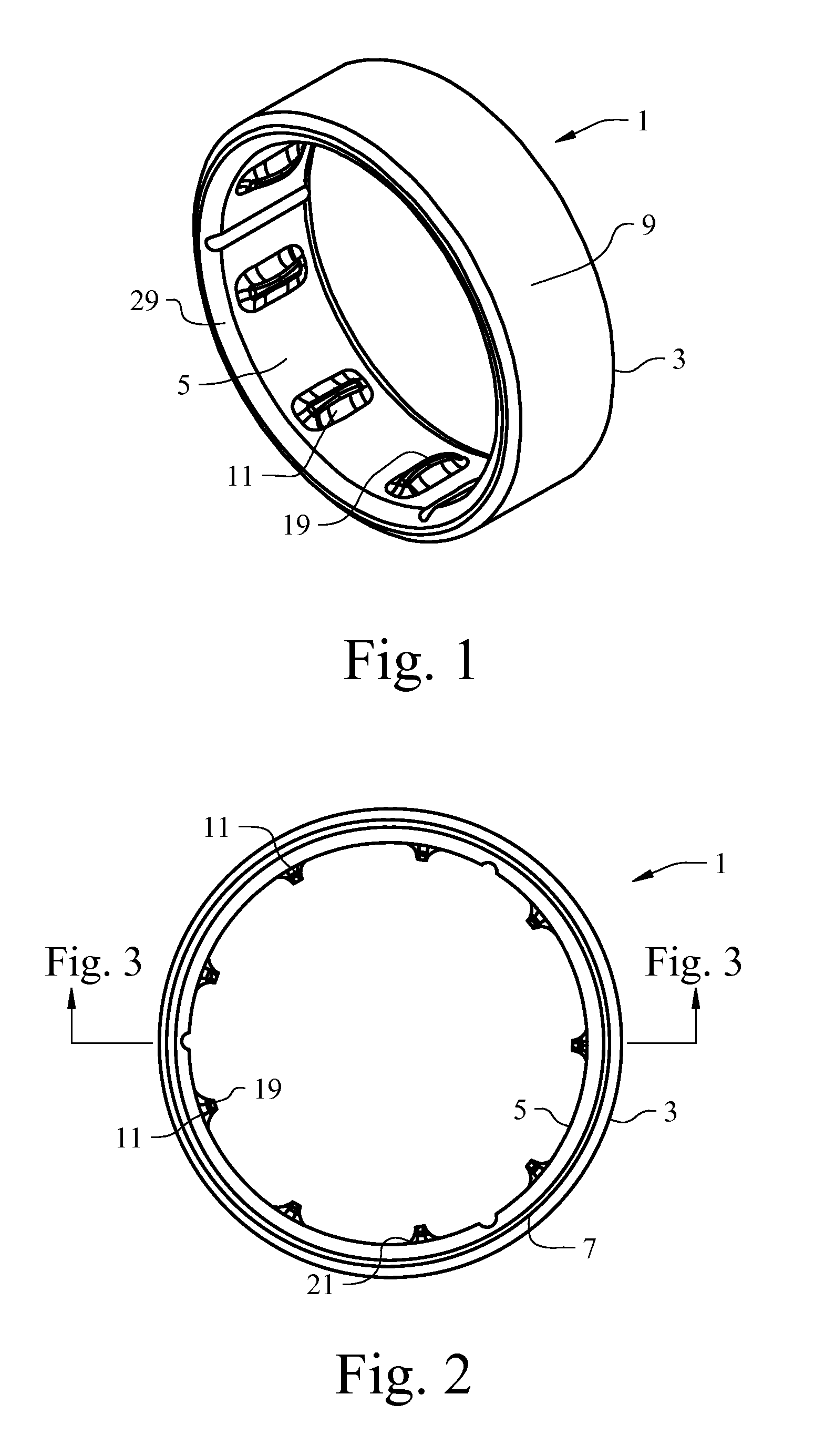[0007]In the present invention, a finger ring is provided which includes a size-accommodating inner liner formed substantially throughout of a pliable, flexible and resilient material. The inner liner is adhered to and extends at least partly around the inner diametrical surface of the outer substrate or band of a finger ring. Although it is preferred that the liner extend completely around the inner diametrical surface of the finger ring, with the improved comfort and
structural integrity provided by the liner design, it is contemplated that the liner could extend only partly around and still provide the benefits described herein.
[0008]In one exemplary embodiment, the outer substrate of the ring may be formed of a substantially rigid material, comprising without limitation, a suitable
metal or plastic material, or a combination of both. The inner liner may be formed throughout of a relatively flexible, pliable elastomeric material, such as
silicone rubber, although it is also conceivable that the liner could be formed of other flexible plastics or
thermoplastic elastomers, or a combination thereof, without departing from the invention herein. The liner is preferably constructed of a self-adhering material having a
high resistance to the aggressive additives typically found in hand lotions, such as
Stearic Acid and Glycol. The liner may then be overmolded to the inner surface of the outer ring substrate, thereby causing the liner to adhere to and extend peripherally around the inner diametrical surface thereof. The liner may also extend substantially across the entire axial width of the ring substrate to enhance the comfort of the ring, which will be described in more detail hereafter.
[0009]A plurality of peripherally spaced flexible ribs or protuberances are formed on the liner and extend radially inward therefrom to help facilitate ease of placement and removal of the ring from a person's finger, and to facilitate adjustment to and / or
accommodation of variances in ring sizes. In one embodiment, each of the ribs extends generally longitudinally across at least a portion of the axial width of the liner. Each rib is constructed with a generally thin profile that tapers radially inwardly from the inner
peripheral surface of the liner, thereby forming a plurality of flexible, resilient rib elements that are configured to readily fold or roll over upon rotation of the ring during placement or removal of the ring upon a finger. By folding over, the flexible ribs facilitate passage of the ring over the generally enlarged knuckle joint of the finger. After passing over the knuckle region, the ribs tend to relax to their original state. This prevents rotation and facilitates proper seating of the ring on the
proximal phalanx of the finger; it also enhances the ability for the finger to breathe better underneath the ring.
[0010]In another exemplary embodiment, the inner diametrical surface of the outer ring substrate is configured with a liner retention shoulder formed adjacent at least one of the
peripheral axial edges of the substrate for helping to retain the liner and
resist the “shearing” forces subjected thereto upon transition of the ring on and off the finger. In one embodiment, a liner retention shoulder is formed adjacent each opposite
peripheral edge portion of the outer ring substrate, thereby defining a central
plateau that extends peripherally around the inner diametrical surface of the ring substrate. The liner then contours and adheres to the profile of the inner diametrical surface of the outer substrate of the ring in interengaging relation, so that much of the “shearing” forces imparted to the liner upon placement or removal of the ring upon the finger are directed into and absorbed by the shoulders formed in the ring substrate.
[0011]In still another exemplary embodiment, the outer diametrical surface of the ring substrate may be formed with one or more channel regions or depressions that form an aesthetically pleasing design of choice. These channels may then be configured to connect with one or more flow-through
weep holes extending between the inner and outer diametrical surfaces of the ring substrate. This allows the liner material, while in its
molten state during the overmolding process, to freely flow from one surface of the substrate to the other. Consequently, the molten liner material is permitted to flow into the channel regions in the outer surface of the ring substrate and adhere thereto to form an outer aesthetically pleasing design to the ring. Notably, once the liner material cures into a hardened state, the liner material extending through the
weep holes to the outer surface of the ring will also function as an added retention member helping to secure the liner to the inner diametrical surface of the ring substrate and further prevent dislodgement therefrom.
[0012]Example embodiments are also provided herewith for methods for accommodating ring transition and ring fit on fingers of varying sizes. In one example embodiment, a method generally includes providing a ring with an inner diametrical liner having a plurality of flexible, resilient ribs or protuberances which tend to roll over upon rotation of the ring during placement or removal thereof from a finger. In another embodiment, the method generally includes providing an outer ring substrate with a liner retention shoulder that will help to absorb potential “shearing” forces and improve comfort upon placement or removal of the ring upon a finger.
 Login to View More
Login to View More 


